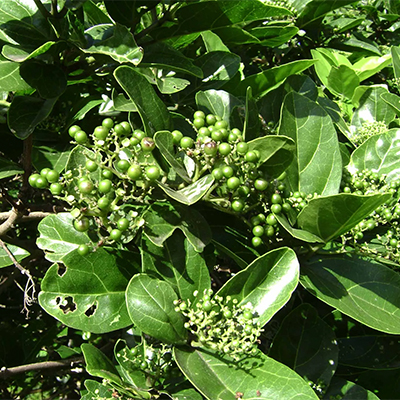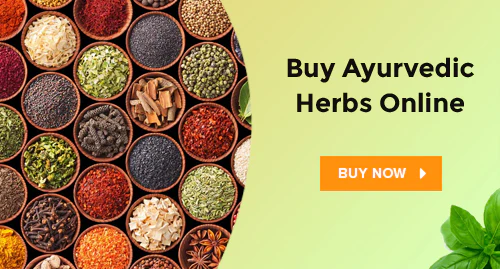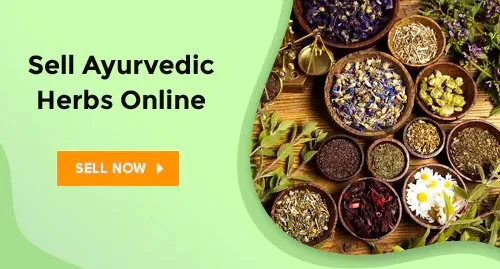On This Page
Agnimantha – The Wind Killer Introduction
In Ayurvedic classical texts, Agnimantha is considered to be the main ingredient of Dashmool as well as Brihat Panchmool. Agnimantha plant is not only used to cure various disorders but is also used in various rituals. As per Ayurvedic classical texts, Agnimantha exhibits Kapha- Vata Hara, Shothara, and Deepan properties, etc. Recent research revealed that Agnimanth has various important active constituents like raffinose, epigenin, premnenol, etc. due to which it possesses anti-inflammatory, anti-arthritic, antimicrobial, antioxidant, hypolipidemic properties, etc.
Basonym of Agnimantha
अग्निं मथ्नाती दीपनत्वात।
When two dried sticks of Agnimantha rubbed each other will produce fire and when administered internally stimulates the digestive fire.
अग्निं मथ्नाती मंथ विलोड़ने। (भा. दी)
अग्नये मथ्यति इति वा। (नि. आ)
It produces fire on the mutual rubbing of its branches.
Synonyms of Agnimantha
- According to habitat:
गणकारिका – गणे समुहे भवा प्रस्रन्ति वा।
Agnimantha grows gregariously.
नादेयी – नद्यां भवा।
It grows gregariously on riverbanks.
- According to morphology
केतुः – पताकेव पुष्प मञ्जरी।
Inflorescence resembles the kite.
वैजयंतिका – पताकेव।
Inflorescence resembles the kite.
- According to properties and action
जया – जयति रोगान।
Agnimantha cures many diseases
जयन्ती – रोगान जयन्ति।
Agnimantha overcomes many diseases.
- Other
अग्नि मंथन – अग्नि मर्थ्यते अनेना रुणि रूपेण।
The Agnimantha stick catches fire like dry cow dung.
अरणिक – अग्नि रूपेण प्रयुज्य मानः।
It can be used as a source of fuel like dried cow dung.
Regional Names of Agnimantha
- Arani, Ganivar, Agethu (Hindi)
- Arni (Gujarati)
- Taggi (Kannada)
- Ganimari (Bengali)
- Thalnaji (Tamil)
- Wind killer (English)
- Tirutali (Malayalam)
- Airan, Eran, Takali (Marathi)
- Nelichett (Telugu)
- Bakorcha (Garwal)
Botanical Name
Brihat Agnimanth
- Premna integrifolia Linn.
Premna is derived from the Greek word Premnon means a stump, low stature of the species
Integri means whole
Folia means leaves
- Premna mucronata Roxb. (Substitute for Agnimantha)
Kshudra Agnimantha
- Clerodendrum phlomides Linn. f
Kleros means chance and dendron is derived from the Greek word that means tree.
Pholomides means resembling phlomis (Jerusalem sage)
Family
Lamiaceae/ Verbenaceae (Nirgundi Kula)
Ayurveda Reference for Agnimantha
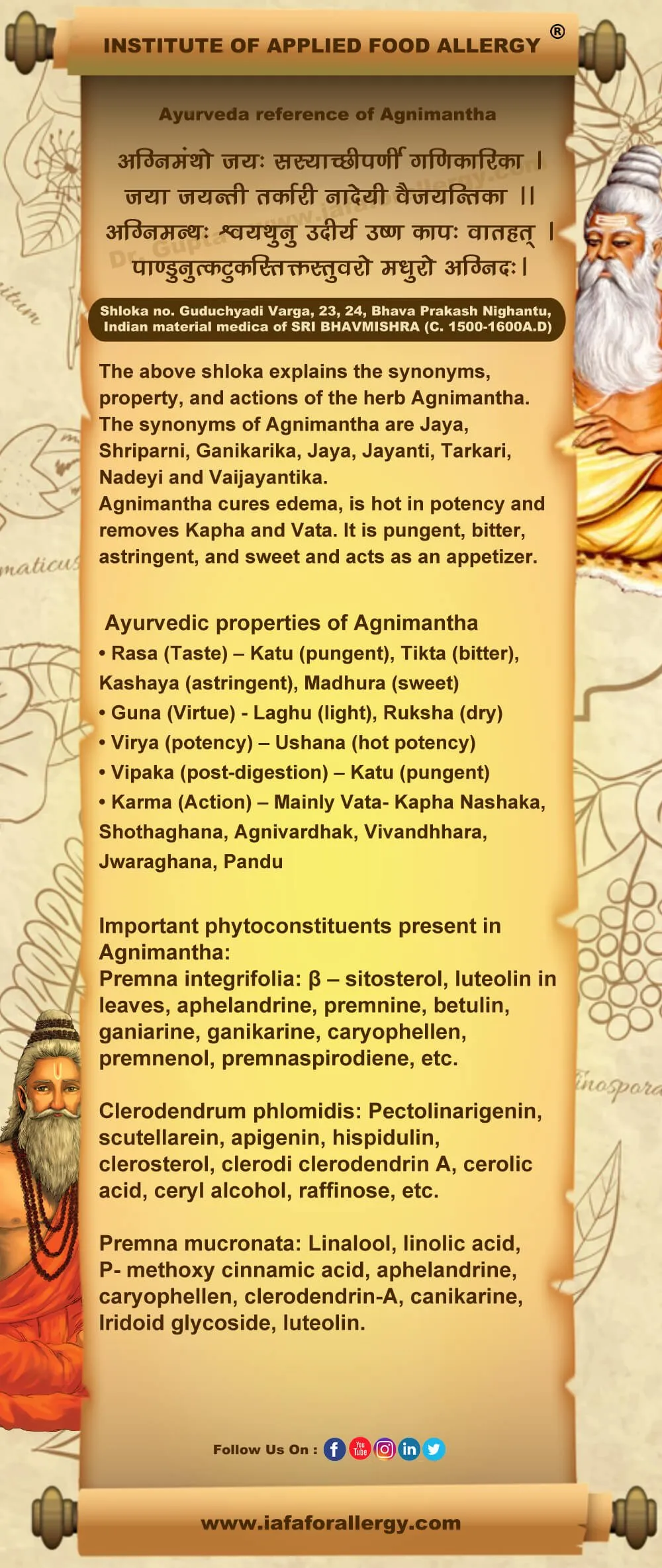
Scientific Classification of Agnimantha
Premna integrifolia Linn.
| Kingdom | Plantae |
| Clade | Tracheophytes |
| Order | Lamiales |
| Family | Lamiaceae (Verbenaceae) |
| Genus | Premna |
| Species | integrifolia |
Classification of Agnimantha as per Charaka and Sushruta
- Charaka: Shotha Hara Mahakshaya, Sheet Prashmana Mahakshaya, Anuvasnopaga Mahakshaya
- Sushruta: Viratarvadi Gana, Varunadi Gana, Brihat Panchmool, Vatashamana
Agnimantha’s Description in Brihtrayi
| Charaka | Shusruta | Vagbhata (Ashtang Hridya) |
| C. S. Su. 2/ 10, 13 | S. S. Su. 11/ 11 | A. H. Su. 14/ 23 |
| C. S. Su. 4/ 26, 38, 42 | S. S. Su. 36/ 3 | A. H. Su. 30/ 10 |
| C. S. Su. 21/ 23 | S. S. Su. 38/ 8, 10, 68, 70 | A. H. Chi. 17/ 30 |
| C. S. Chi. 1. 1/ 41, 60 | S. S. Su. 39/ 7 | A. H. U. 20/ 16 |
| C. S. Chi. 3/ 266 | S. S. Chi. 10/ 12 | |
| C. S. Chi. 6/ 27 | S. S. Chi. 11/ 9 | |
| C. S. Chi. 13/ 169 | S. S. Chi. 27/ 11 | |
| C. S. Chi. 14/ 46 | S. S. U. 36/ 3 | |
| C. S. Chi. 21/ 125 | S. S. U. 39/ 213 | |
| C. S. Chi. 27/ 54, 55 | ||
| C. S. Si. 10/ 18, 29 |
Agnimantha’s Description as synonym Aranika in Brihtrayi
- A. H. Su. 15/ 24
- A. H. Chi. 14/ 117
Agnimantha’s Description as synonym Jayanti in Brihtrayi
- A. H. Chi. 17/ 26
Agnimantha’s Description as Jaya Dvaya in Brihtrayi
- C. S. Chi. 9/ 51
- A. H. Su. 15/ 21
- A. H. U. 6/ 35
Tarkari (Clerodendrum phlomidis) Description in Brihtrayi
Charaka
- C. S. Vi. 8/ 158
- C. S. Chi. 8/ 176
- C. S. Chi. 26/ 137, 152, 235
- C. S. Chi. 27/ 50, 54
Shusruta
- S. S. Su. 38/ 7
- S. S. Su. 46/ 254
- S. S. U. 17/ 51
- S. S. U. 21/ 6
- S. S. U. 35/ 3
Ashtanga Hridya
- A. H. Su. 6/ 97, 167
- A. H. Chi. 1/ 76, 157
- A. H. Chi. 5/ 79
- A. H. Chi. 14/ 110
- A. H. Chi. 15/ 46
- A. H. Chi. 17/ 36
- A. H. Chi. 21/ 52
- A. H. U. 20/ 5
- A. H. U. 22/ 66
Agnimantha’s Description as synonym Naadyeyi in Brihtrayi
- S. S. Chi. 4/ 32
Agnimantha’s Description as synonym Vaijyanti in Brihtrayi
Shusruta
- S. S. Su. 42/ 18
- S. S. Chi. 4/ 32
- S. S. Chi. 11/ 8
- S. S. Chi. 19/ 39
Ashtanga Hridya
- A. H. U. 3/ 44
Haritaki’s description in Brihtrayi as Amrita Dvaya
By Amrita- Dvaya (two Amritas), Guduci and Haritaki are understood. One of the two Amirtas is undoubtedly Guduci and the other is Haritaki as is clear by comparing identical preparations (Yogas ) such as Chyavanaprasu Yogas in C. S., A. H., and also C. S. Ci. 29. 33 and A. H. Ci. 22. 12.
Sushruta Samhita: S. S. Chi. 37/ 20
Vagbhata: A. H. U. 39/ 34
Haritaki’s description in Brihtrayi as Avyatha
Charaka Samhita: C. S. Su. 4/ 49, C. S. Sa. 8/ 29, 89
Vataja and Kaphaja Vyadhi (Disorders of Vata and Kapha): Haritaki is specifically efficacious in disorders of Vata and Kapha. (Ashtanga Hridya Uttara Tantra. 40/ 48)
Haritaki’s description in Brihtrayi as Trivarga
Sushruta Samhita: S. S. Chi. 2/ 73, S. S. Chi. 24/ 7, s. s. u. 41/ 45, S. S. U. 56/ 15
Haritaki’s description in Brihtrayi as synonym Vyastha
This is interpreted differently to mean Amalaki, Guduchi, Brahmi, and Haritaki at different places by the commentators.
Charaka Samhita: C. S. Su. 4/ 48, C. S. Vi. 8/ 158, C. S. Sa. 8/ 93, C. S. Chi. 9/ 52, 63, C. S. Chi. 10/ 25, 46, C. S. Chi. 17/ 139, C. S. Chi. 26/ 82
Sushruta Samhita: S. S. U. 32/ 4, S. S. U. 36/ 6, S. S. U. 60/ 46, 48
Haritaki’s description in Brihtrayi as synonym Vijaya
Charaka Samhita: C. S. Chi. 25/ 46
Sushruta Samhita: S. S. U. 24/ 21, S. S. U. 39/ 194
Vagbhata (Ashtanga Hridya): A. H. Chi. 3/ 167, A. H. Chi. 8/ 23, 70, A H. Chi. 14/ 31, 36, 99, A. H. Chi. 17/ 2, A. H. U. 39/ 16
Haritaki’s description in Brihtrayi as Shiva
Charaka Samhita: C. S. Su. 4/ 49, C. S. Sa. 8/ 29, 89
Vagbhata (Ashtanga Hridya): A. H. U. 39/ 169
The Controversy of Agnimantha
In the Ayurvedic classics, Agnimantha is considered under the descriptions of Jaya- Dwaya by Charaka Samhita and Ashtanga Hridya. The two drugs namely Agnimantha and Tarkari were quoted simultaneously in several contexts. Amarakosha dealt these two drugs separately with synonyms like Jaya, Jayanti, Nadeya, Vyjayantika for Tarkari and, Shriparni, Agnimantha, Karnika, Ganikarika for Agnimantha. But Bhavamishra enumerated all these synonyms for Agnimantha only. In ancient times two drugs namely Ashwattha and Shami were used for the preparation of fire during Vedic rituals. Acharya Priyavrata Sharma opines that over time these drugs must have been replaced with Agnimantha and Tarkari. Thakur Balvant Singh considers Premna integrifolia Linn. as Kshuragnimantha i.e thorny Agnimantha and Clerodendrum phlomidis Linn. f as Akshuragnimantha (non-thorny Agnimantha), while other scholars identified them as Brihat and Laghu varieties of Agnimantha. Sharngadhara mentioned Agnimantha-dwaya in the formulation of Varunadika yoga and the commentator Adhamalla interpreted it as Tarkari and Arani. According to this reference, the botanical sources for Tarkari and Arani should be considered as Premna integrifolia and Clerodendrum phlomidis respectively.
External Morphology of Agnimantha
Brihad Agnimantha:
1. Premna integrifolia Linn.
It is a large shrub of 1-2.5 m high, or a small tree, reaching a height of 8m. The trunk is sometimes spiny.
- Branches: Branches and twigs are somewhat hairy and spinescent.
- Leaves: Leaves of P. integrifolia are simple, opposite, petiolate, lamina 5-9* 3-6 cm, broadly elliptic, apex shortly acuminate, base rounded or somewhat narrowed, margins entire or upper part toothed, petiole 0.7-1.5cm long.
- Inflorescence: Terminal inflorescence, panicle corymbose cymes. Flowers greenish-yellow emitting a somewhat unpleasant odor, bracts minute, calyx 2mm long, 2-lipped, corolla tube 3mm long with 4 oblong lobes, hairy in the throat, glabrous outside, stamens 4.
- Fruit: Pear-shaped, 4mm long, bony, ridged, and 4 – seeded.
- Flowering and fruiting time
- Flowering – December-March
- Fruiting – February onwards
2. Premna mucronata Roxb.
- Habit: It is a small tree.
- Bark: Thin, pale, exfoliating.
- Branches: Spiney.
- Leaves: Ovate-oblong, long acuminate, base rounded, cordate or tapering, entire or irregularly dentate.
- Flowers: Arranged in terminal, corymbose, trichotomous panicles and are greenish.
- Fruits: A globose drupe, green when young, dark at maturity.
- Seeds: Dark color.
Kshudra Agnimantha
1. Clerodendrum phlomidis Linn. f
It is a large shrub of 2-3m high with profuse branching, sometimes attaining a height of 6m to become a small tree.
- Branches: Branches and twigs are more or less hairy, and lighter in weight when dried.
- Leaves: Leaves are simple, opposite, petiolate, lamina 4-6*3-4 cm, ovate-sub-rhomboid in shape, apex- obtuse-angled, base– truncate – subcordate, margins- coarsely crenate dentate, petiole 1.5-2 cm long.
- Inflorescence: Few–flowered, dichotomous, axillary cymes or arranged to form terminal panicles, bracts leafy, calyx divided halfway down. Lobes acute, corolla white or shaded with pink, tubular, 2-2.5cm long, lobes 5, elliptic, obtuse, slightly hairy outside, stamens 4.
- Fruit: Fruit is a 4-lobed drupe, about 0.6 cm long, broadly obovoid, depressed, exceeding the persistent calyx, with one nutlet in each lobe, sometimes1-3 nutlets abortive, leaving behind only one to mature.
Flowering and fruiting time
- Flowering – Throughout the year.
- Fruiting – September-March.
Diagnostic Characters of Bark of Premna integrifolia and Clerodendrum phlomidis.
Premna integrifolia
- Shape: Cylindrical, gnarled roots or their longitudinally split pieces.
- Surface: Surface rough, longitudinally wrinkled, yellowish-brown in color with small round root scars. The debarked surface is silky yellow and longitudinally striated. The surface of the transversely cut root shows a closely adhering thin bark, followed by a narrow cortical region, a large woody portion with prominent concentric rings, and a small central pith.
- Fracture: Short
- Odor: Mild and pleasant
- Taste: Astringent
Clerodendrum phlomidis
- Shape: Pieces of cylindrical split somewhat twisted, gradually tapering roots, up to 3 cm in diameter.
- Surface: Surface is longitudinally fissured, yellowish-brown in color, transversely cut portion shows a creamish yellow. Surface enclosed by an easily separating thin bark, well-defined annual rings, and a central pith of dark brown color.
- Size: The bark occurs in small flat or slightly curved and friable pieces of 1.5 to 2 mm thickness. These have a brown exfoliating inner surface.
- Fracture: Short
- Odor: Slightly pungent
- Taste: Bitter
Distribution of Agnimantha
Premna integrifolia: The plant is globally distributed in Malacca and Sri Lanka. In India, the plant is found growing wild in all the coastal districts of various states namely: West Bengal, Andhra Pradesh, Orissa, Tamilnadu, Kerala, Maharastra, Karnataka, Gujrat, and Andamans. Scrub jungles and forest outskirts are the natural habitats of the taxon.
Clerodendrum phlomidis: The plant is globally distributed in Srilanka. It is generally grown throughout India, by farmers as hedge plants around cultivated fields and orchards. Sometimes it is planted in gardens and backyards for its sweet, scented flowers. In such situations, it attains the size of a small tree with a straight trunk of a few meters.
The Useful Part of Agnimantha
Root, Bark, and Leaves.
Important Phytoconstituent of Agnimantha
- Premna integrifolia: β – sitosterol, luteolin in leaves, aphelandrine, premnine, betulin, ganiarine, ganikarine, caryophellen, premnenol, premnaspirodiene, etc.
- Clerodendrum phlomidis: Pectolinarigenin, scutellarein, apigenin, hispidulin, clerosterol, clerodendrin A, cerolic acid, cetyl alcohol, raffinose, etc.
- Premna mucronata: Linalool, linolic acid, P- methoxy cinnamic acid, aphelandrine, caryophellen, clerodendrin-A, canikarine, Iridoid glycoside, luteolin.
Recent Research on Agnimantha
- Analgesic
- Anti-inflammatory
- Anti-bacterial
- Anti-arthritic
- Antimicrobial
- Hypolipidemic
- Antioxidant
- Anti-ulcer
- Cardiac stimulant
- Hepatoprotective
- Hypoglycemic
- Immunomodulatory
- CNS depressant
Rasa-Panchaka (Properties) of Agnimantha
| Rasa (Taste) | Katu (pungent), Tikta (bitter), Kashaya (astringent), Madhura (sweet) |
| Guna (Virtue) | Laghu (light), Ruksha (dry) |
| Virya (potency) | Ushana (hot potency) |
| Vipaka (post-digestion) | Katu (pungent) |
| Dosha Karma (action on Dosha) | Mainly Vata- Kapha Nashaka, Shothaghana, Agnivardhak, Vivandhhara, Jwaraghana, Pandu |
Prayogarha Vyadhi (Therapeutic Indication) of Agnimantha
- Swayathu
- Pandu
- Vivandha
- Jwara
- Arsha
- Adhmana
- Agnimandya
- Ikshumeha
- Sheet Pitta
- Stholya
- Udara Roga
Aamyik Prayog (Therapeutic Uses) of Agnimantha
- Prameha (Diabetes):
- Susruta recommends the use of the decoction of Agnimantha or Simsapa in Vasameha. (Susruta Samhita Chikitsa Sthana. 11/ 9)
- Vagbhata and Vrinda mentioned only Agnimantha Kashya in this disorder. (Ashtanga Samgreha Chikitsa Sthana. 14/ 3 and Vrinda Madhava 35. 13)
- Stholya (Obesity): Charaka prescribes the decoction of Agnimantha as a good remedy for obesity. (Charaka Samhita Sutra Sthana. 21/ 24)
- Arsha (Piles): The patient with piles, in case of pain, should take, after the oily massage, a tub-bath in the decoction of the leaves of Agnimantha, Sigru, and Ashmantaka. (Charaka Samhita Chikitsa Sthana. 14/ 45)
- Granthi-Visarpa (Glandular Erysipelas): In the glandular type of erysipelas, the paste of bamboo leaves and Agnimantha should be applied locally. (Charaka Samhita Chikitsa Sthana. 21/ 125)
- Urustambha (Stiffness of Thigh): The part should be sprinkled with the decoction of Agnimantha and Karanja. Moreover, the paste of these drugs pounded with cow urine should be applied locally. (Charaka Samhita Chikitsa Sthana. 27/ 57)
- Inflammation: In inflammation caused by Vata, the paste prepared of Matulunga, Agnimantha, Devdaru, Sunthi, Ahimsra, and Rasna should be applied on the spot. (Sushruta Samhita Sutra Sthana. 37/ 3)
- Sheet Pitta, Udard, Kotha (Urticarial manifestation): The root (bark) of Agnimantha pounded and taken with ghee alleviates Sheeta Pitta, Udarda, and Kotha (urticarial manifestations) within a week. (Chakradutta. 51/ 7)
- Shotha (Oedema): Water is boiled and cooled and mixed with the alkali of Arani (Agnimantha). Intake and the local application of this for three days alleviates edema in the abdomen. (Gada Nigreha. 2. 33. 69)
- Vyanga (freckle): Vyanga is removed by application of the paste of Arani bark pounded with goat’s milk. (Gada Nigreha. 4. 10. 101)
Important Benefits of Agnimantha
- Diabetes (Parmeha): Agnimantha plant exhibits hypoglycemic activity. Therefore, very helpful for patients with Diabetes.
- Anorexia (Aruchi): Agnimantha promotes proper assimilation of food, treats heaviness in the abdomen, and digests food properly by its Deepana property i.e its appetizer and digestive properties.
- Obesity (Stholya): Agnimantha with its hypolipidemic effect, improves the metabolism of the fat, prevents fat accumulation, and as a result of which it reduces weight.
- Lymphadenitis: Agnimantha with its anti-bacterial, anti-inflammatory, and anti-viral properties reduces inflammation, and inhibits the growth of microbes. thus helping to reduce pain and inflammation of lymph nodes.
Matra (Therapeutic Administration and Dosage) of Agnimantha
- Churna (powder): 1- 3 grams
- Swarasa (juice): 10- 20ml
- Kwatha (decoction): 50- 100ml

Have A Health Issue?
Consult Online
- Dr. Sahil Gupta (B.A.M.S., M.H.A.)
Ayurvedic Allergy Specialist
CEO & Founder of IAFA®
Classical Reference of Agnimanth
Susruta Samhita Chikitsa Sthana. 11/ 9
वसा मेह
वसा मेहिनम अग्निमंथ कषायं शिंशपाकषायं वा ।
Ashtanga Samgrha Chikitsa Sthana 14/ 8
तत्र वसामेहे अग्निमंथस्य ।
Vrinda Madhava. 35/ 13
अग्निमन्थकषायं तु वसामेहे प्रयोजयेत्।
Charaka Samhita Sutra Sthana. 21/ 24
स्थौल्ये
शिलाजतुप्रयोगश्च साग्निमन्थरस: पर: ।
Charaka Samhita Chiktsa Sthana. 14/ 45
अर्शसि
अग्निमंथस्य शिग्रोश्च पत्राण्यश्मन्तकस्य च ।
जलेनोत्कवाथ्य शूलात्त स्वभ्यक्तमवगाहयेत् ॥
Charaka Samhita Chiktsa Sthana. 21/ 125
ग्रंथि विसर्पे
वंशपत्राण्यम्निमंथ कुर्याद् गन्थिप्रलेपनम् ।
Charaka Samhita Chiktsa Sthana. 27/ 57
ऊरुस्तम्भे
अग्निमंथ करंजो च जलेनोत्कवाथ्य सेच्येत।
प्रलेपो मूत्र पिष्टे वाप्य उरूस्तम्भ निवारण:।।
Sushruta Samhita Sutra Sthana. 37/ 3
वातजे व्रणशोथे
मातुलुंगय अग्निमंथो च भद्र दारु महौषधं।
अहिंस्रा चैव रास्ना च प्रलेपो वातशोफजित्।।
Chakra Dutta. 51/ 7
शीत पित्त
अग्निमन्थभव मूलं पिष्टं पित्तच्च सर्पिषा।
शीतपित्तोदर्दकोठान् सप्ताहादेव नाशयेत्।।
Gada Nigreha. 2. 33. 69
शोथे
अरणीक्षारसंमिश्रे तोयं कवथित शीतलम्।
त्रि दिनं पानतो अभ्यंगच्छोफं हन्त्युदरोदभवम्।।
Gada Nigreha. 4. 10. 101
व्यंगा
तद्वा अरणीत्वगथवा दगलीस्तनोत्थक्षीरान्विता क्षपयति प्रसभं प्रलेपात्।
Bhava Prakasha Guduchyadi Varga- 23
Synonyms
अग्निमंथो जय: सस्याच्छीपर्णी गणिकारिका ।
जया जयन्ती तर्कारी नादेयी वैजयन्तिका ।।
Properties, action and indication
Bhava Prakasha Guduchyadi Varga- 24
अग्निमन्थ: श्वयथुनु उदीर्य उष्ण कापः वातहत् ।
पाण्डुनुत्कटुकस्तिक्तस्तुवरो मधुरो अग्निद:।
Dhanwantri Nighantu Guduchyadi Varga- 110
तर्कारी कटुका तिका तथोष्णा अनिलपाण्डुजित् ।
शोफ श्लेष्माग्रिमान्दयाम विवन्धश्च विनाशयेत् ।।
Kaideva Nighantu Aushadiadi Varga- 25 to 28
तर्कारी कटुका तिक्ता तुवरा मधुरा अग्निदा।
विर्यो उशन हरते वात कफः श्वयथु पाण्डुता: ।
अग्निमंथो गुणै तद्वदी शेषादवात शोफहा।।
Priya Nighantu Haritkyadi Varga , 29
अग्निमंथो रसे तिक्त: कषायः कफवातनुत्।
वीर्य उष्ण शोथहत वह्लिदीपनों ज्वरनाशनः ।।
Raja Nighantu Prabhadradi Varga, 23- 25
तर्कारी कटुरूष्ण च तिक्ता अनिलकफापहा।
शोफश्लेष्मा अग्निमान्द्यो अर्शो विड् बन्धाध्मान नाशनी ।।
अग्निमन्तः द्वयं चैव तुल्य वीर्यरसादिषु।
तत् प्रयोगानुसारेण योजयेत स्वमनीषया ।।
Priya Nighantu Haritkyadi varga, 30
उष्णत्वाद्यो हरति मरुतः शीतजन्य प्रकोपम् ।
कोपो यस्य प्रणुदति रुजः पादप: सो अग्निमन्थः ।।
Specific Formulation of Agnimantha
- Dashamoola Arishta for Aruchi, Shoola, Swasha Roga
- Dashamoola Kwatha for Jwara, Kasa, Swasa
- Dhanvantari Ghrita for Kustha, Parmeha, Shotha
- Narayana Taila for Parkupita Vaata, Vaata Vyadhi
- Indukanta Ghrita for Vatavyadhi, Kshaya
- Pratham Brahma rasayana for Ayu Vardhaka
- Agruvadi taila for Sheeta Jvara
- Maladi Lepa for Visarpa
- Chyavanaprasha
- Maha Prasarni Taila
- Maha Masha Taila
- Agnimanthadi Lepa
- Agnimanthadi Dhoomapana
- Bilvadi Sura
- Agastyadi Haritaki
Contraindication and Side Effects of Agnimantha
If Agnimantha is used as per the prescribed dosage after proper analysis of Dosha, then no side-effect is seen.
Avoid the use of Agnimantha during pregnancy and lactation.
Suggestive Reading Regarding Agnimantha
- Aggarwal, Nishant & Singh, Ritu. (2022). A LITERARY REVIEW ON THE MEDICINAL IMPORTANCE OF AGNIMANTHA.
- Aparna S, Ved DK, Lalitha S, Venkatasubramanian P. Botanical identity of plant sources of Daśamūla drugs through an analysis of published literature. Anc Sci Life. 2012; 32:3–10.
- George KV, Samuel KA, Abraham J, George BP. Investigations on bioactive compounds of Premna integrifolia Linn. 2008.
- Mali PY, Bhadane VV. A comparative account of screening of bioactive ingredients of Premna integrifolia Linn. with special reference to the root by using various solvents. J Pharm Res. 2010;3: 1677–79.
- Gokani RH, Kapadiya NS, Shah MB. Comparative pharmacognostic study of Clerodendrum phlomidis and Premna integrifolia. J Nat Remedies. 2008;8: 222–31.
- Kumar KU, Soma P, Kumar SS, Chandra SM, Kumar BS. Assessment of analgesic and antibacterial activity of Premna integrifolia Linn. (Family: Verbenaceae) leaves. Int J Pharm Sci Res. 2011;2: 1430–5.
- Khatun H, Majumder R, Mamun A, Alam EK, Jami SI, Alam B. Preliminary pharmacological activity of the methanolic extract of Premna integrifolia barks in rats. Avicenna J Phytomed. 2014; 4: 215–24.
- Paul John JA, Selvi BK, Karmegam N. Biosynthesis of silver nanoparticles from Premna serratifolia L. leaf and its anticancer activity in CCl4-induced hepato-cancerous Swiss albino mice. Appl Nanosci. 2015. [Last accessed on 2015 Aug 25]. pp. 1–8.
- Habtemariam S, Varghese GK. A novel diterpene skeleton: Identification of a highly aromatic, cytotoxic, and antioxidant 5-Methyl-10-demethyl-abietane-type diterpene from Premna serratifolia. Phytother Res. 2015; 29:80–5.
- Sasidharan N. Peechi: Kerala Forest Research Institute; 2010. Qualitative and quantitative analysis of biologically active principles, baicalein, luteolin, and psoralen from Oroxylum indicum, Premna serratifolia, Aegle marmelos, and their Allied Species. KFRI Research Report No. 350 (KFRI/486/05) pp. 1–57.
- Gokani RH, Lahiri SK, Santani DD, Shah MB. Evaluation of anti-inflammatory and antioxidant activity of Premna integrifolia root. [Last accessed on 2016 March 02]; J Complement Integr Med. 2011
- Rajendran R, Suseela L, Meenakshi SR, Saleem BN. The cardiac stimulant activity of bark and wood of Premna integrifolia. Bangladesh J Pharmacol. 2008; 3:107–13.
References
- Agnivesha, Charaka, Dridhabala. In: Charaka Samhita, ed. Vaidya Jadavaji Trikamji Aacharya., editor. Varanasi: Chaukhamba Sanskrit Sansthan; 2009.
- Sushruta. In: Sushruta Samhita, Sutra Sthana, ed. Vaidya Jadavji Trikamji Acharya., editor. Varanasi: Choukhambha Orientalia; 2005.
- Vagbhata. In: Ashtanga Hrudaya, 9th ed. Anna Moreshwar Kunte, Krishnashastri Navarre, Harishastri, editors. Varanasi: Choukhambha Orientalia; 2005.
- Bhavamishra. In: Bhava Prakasha Nighantu, Guduchiyadi Varga 11th ed. part 2. Brahma Shankara Mishra., editor. Varanasi: Choukhambha Bharati Academy; 2009.
- Bhavprakasha, commentary by Bulusu Sitaram, forwarded by K.C. Chunekar
- Sharma PV, Kaideva Nighantu. Aushadhi Varga. Chaukhamba Orientalia, Varanasi; 2006:
- Tripathi I., Raja Nighantu, Guduchyadi Varga, Chaukhamba Krishnadas Academy; Varanasi; 2010
- Dr. Gyanendra Pandey, Dravyaguna Vigyana, reprint 2012, Chwkhamba Krishnadas Academy
- K. niteshwar Dravyagunavigyana, reprint 2017.
- Dr. J.L.N. Sastry and Dr. B.S. Sastry, Dravyaguna Vigyana, Chaukhambha Orientalia, Varanasi.
- Priya Nighantu by P. V. Shrama, Haritkyadi Varga
- Chakrapanidatta, chakradatta with the vaidayaprabhahindi commentary by indradevatripathi, chaukambha sankritasansthan, varanai 2nd Edition, 1994
Ayurveda is an Indian system of medicine that is popular since ancient times. Dr. Gupta’s IAFA® has been conducting research studies to find out different phytoconstituents of herbs and their action in the body. Such knowledge acquired by our experts is used in the preparation of medicines and providing the treatment facilities safely and effectively. IAFA® is the provider of safe and effective treatment for a wide range of diseases, mainly allergic diseases all based on Ayurveda.
Was this Page Helpful?
Read More Articles
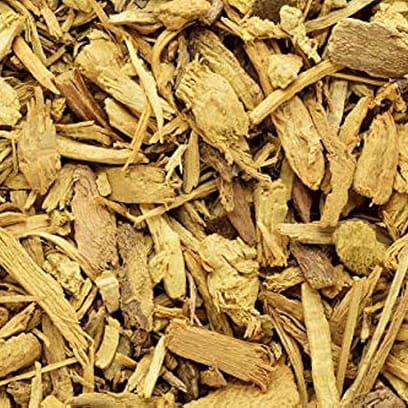
Daruharidra (Berberis aristata)
Explore the uses, benefits, and medicinal properties of Daruharidra (Berberis aristata), also…
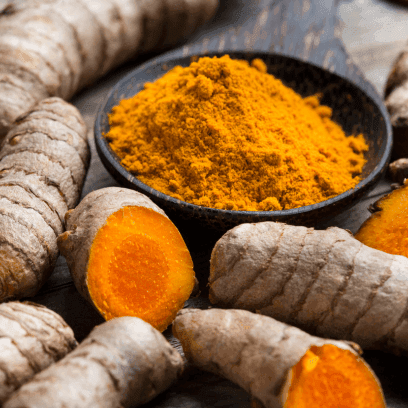
Haridra (Curcuma longa)
Discover the uses, benefits, and medicinal properties of Haridra (Curcuma longa), also…
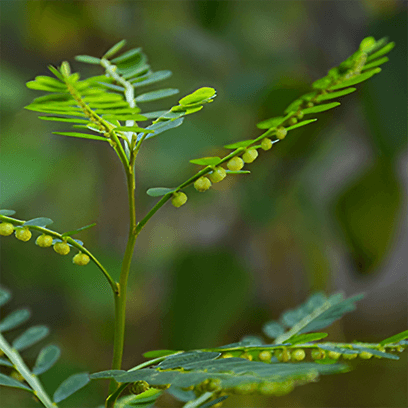
Bhumi Amla (Phyllanthus Niruri)
Know the Uses, Benefits and Medicinal Properties of Bhumi Amla (Phyllanthus Niruri).…

